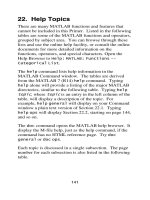getting help
Bạn đang xem bản rút gọn của tài liệu. Xem và tải ngay bản đầy đủ của tài liệu tại đây (212.08 KB, 12 trang )
Chapter 15
Getting Help
Chapter 15
Getting Help
Tim, a 16-year-old from Los Gatos, California, downloaded a write-your-own-virus tool-
kit off the Internet. Tim was getting into programming and, like most teens who write
viruses, he was up for a new challenge.
With the do-it-yourself virus kit in hand, Tim was able to construct his own virus in re-
cord time. He didn’t release it into the wild, of course. Becoming a black hat was never
Tim’s goal. He just wanted to know that he could do it if he wanted to. He wasn’t really
thinking like a bad guy.
That was actually the source of his downfall. If he had been thinking like a malicious
hacker, it would have occurred to him that viruses are pretty nasty bits of code. While
his hacker toolkit made it almost embarrassingly simple to create his malicious code,
it didn’t tell him squat about how to get rid of the new
virus.
The end result? The would-be
hacker completely trashed
his own computer system.
That’s something to think
about if you’re tempted to
try your hand at creating
malicious code or even post
a less-than-politic blog entry.
On the Internet as well as in
real life, you nearly always
get what you give.
212
Chapter 15
So far, every chapter in this book has started out with a teen security story. In
addition to being true, most of these stories are about how easy it is to fall vic-
tim to hackers and malicious code if your PC isn’t protected by the right security
software.
Since Michelangelo and other famous viruses propelled the concept of protective
software into the public view, the tools available to defend home computers have
become awfully diverse and complicated. In the past, you could get away with just
a firewall. Then you needed antivirus protection, then protection against SPAM,
then anti-spyware, then intrusion detection, possibly web filtering, privacy and
anti-fraud. The list gets longer each year. That’s good for security vendors, but not
so good if you have to buy licenses to run all of this software, and renew those
licenses every year.
Before you purchase any security products, you need to understand which com-
ponents are critical. Some security vendors offer bundled solutions—combining
multiple products under one license. This is especially important if you have more
than one computer to protect. As your home computing power grows (and it will),
you’ll want to simplify computer security. A good way to do that is to combine as
many features as possible under one license. If the vendor you are using doesn’t do
that, find another vendor.
15.1 Security Essentials
There are essential security products (and downloads such as patches) that you
MUST have in order to keep nasty code and unwanted visitors off your computer
system. These essential features are
• Patches—To prevent problems before they happen.
• Antivirus software—To keep new viruses from infecting your machine.
• Anti-adware and anti-spyware software—To protect you from both spyware
and adware.
• Firewall protection—To keep unwanted visitors at bay.
• Backup software—To keep your files available, just in case.
Getting Help
213
You’ll notice that the first feature here is more a procedure than a product. That is,
you don’t so much buy patches as you either make it a habit to apply them or—
even better—you configure your machine so that patches are applied automatically.
Much of the malicious code that protective software wards off or removes can be
avoided by making sure that any security holes in your operating system, applica-
tion programs, and protective tools are patched as soon as those security holes are
identified. For now, just keep in mind that applying patches is absolutely essential.
Failing to do so can keep the rest of the tools we’re about to discuss from working
properly, or in some cases, even working at all.
The other items listed above form a category called “protective software.” In a
perfect world, you could run to Best Buy, walk to the aisle labeled “Protective
Software” and pick up any one of a hundred perfect programs that would each
meet every one of your computer protection needs.
Real life isn’t that simple. Most protective software on the market includes two
or more of the features listed above. Your mission is to find the right combination
of products and procedures to perform all five. Because some vendors do bundle
multiple security solutions under one license, you may be able to get all of these
features in one product in a way that meets your needs. Keeping to one product
makes things easier to administer at home. You have to decide, however, whether
the features being bundled give you all the security you need. And, of course, you
do often get what you pay for. The more robust and feature-packed packages are
usually more expensive. Only you can determine what it’s worth to protect your
computer, your data, your privacy, and your identity.
15.2 Additional Niceties
The last section discusses the absolute necessities for security. There are also ad-
ditional features that aren’t quite necessary but may make your life much, much
easier. These include:
• SPAM blocking/filtering
An incredible amount of malicious code travels via unwanted, unsolicited
email. Blocking SPAM reduces your exposure to this code. It also saves you
a lot of wasted time and general annoyance. SPAM blocking is offered as a
214
Chapter 15
feature on many packages designed to eliminate spyware as well as in some
antivirus packages.
• SPIM blocking/filtering
SPIM is the instant message version of SPAM. A first line of defense in
blocking SPIM is turning on your “buddy list.” You might also want a
product for IM authentication and encryption, logging IM communications,
and so on. Encryption is critical because anything you send out over IM goes
out in the clear. So if you value your inheritance, don’t use IM on the same
computer your parents use for online banking! Also check that your antivirus
software looks for malicious code in IM attachments.
• Anti-fraud, Privacy, and Identity protection
Many computer security packages now include anti-fraud protection, privacy
protection, and identity fraud protection. Identity fraud and privacy invasions
are rapidly becoming the largest problems facing computer users. If the
product that you’re using doesn’t protect you from these threats, you may
want to consider switching vendors.
• Intrusion prevention
Detecting attacks and potential intrusions used to be something that only
large corporations really worried about. That was before home computer
users found that their machines had been drafted to bot armies for
coordinated denial of service (DoS) attacks. Most, but not all, firewalls
include intrusion prevention.
• Email and file encryption
Encryption is a double-edged sword. While it’s useful in protecting your data,
unless used carefully it can protect your data so well that even YOU can’t
read it. On the plus side, if you do opt to encrypt, some of the best tools are
either free or included in your operating system. For email encryption, the
gold standard is Pretty Good Privacy (PGP) from pgp.com. The downside is
that PGP works only if the people you’re sending email to also use it. Disk
encryption is actually provided within Windows 7. Encrypt with care though.
Some better options might be password protecting your files and always
Getting Help
215
keeping in mind that anything you send out over email could easily become
public knowledge. Send only emails that you wouldn’t mind reading as
headlines in the New York Times.
• Pop-up blockers
Several of the nastier versions of adware circulating in 2010 made the rounds
by masquerading as free spyware checkers. While these versions had little in
common (they were made by different companies and even originated in dif-
ferent countries) what they all shared was that they nabbed users by showing
up as pop-up windows. Having read this far into the book, you are no doubt
MUCH too security-savvy to fall for this particular trick. However, if you
share a computer with a younger sibling or less security conscious classmates,
you could easily fall victim to this ruse. Blocking pop-ups is a great way to
eliminate that risk.
15.3 Bundled Security Solutions
Although it’s unlikely that you’ll find a single product that meets all of your com-
puter security needs, you still might consider purchasing a bundled approach. At
the very least, make sure that the solution you buy includes more than just antivi-
rus protection.
Buying a bundled approach has a number of advantages. First, every security
product you buy has a license. When that product is upgraded, you need to pur-
chase the upgrade. This has a number of financial repercussions. Obviously, if you
buy four separate programs to protect your machine, you’re paying for four dif-
ferent licenses. Even if you pick up your protective software as “freeware,” you’re
still investing time and energy to evaluate, select, download, and install those four
packages. Where this becomes even more cumbersome, and potentially expen-
sive, is when you start looking at upgrades for all four of those products as well.
In addition to the expense of paying for separate upgrades, you’re also hit with
the time factor of continually applying updates. With four vendors, it’s unlikely
that upgrades will be offered at the same time. You could be renewing your virus









